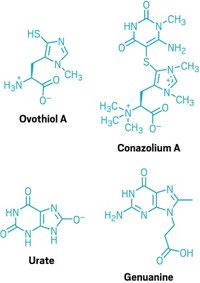Advertisement
Grab your lab coat. Let's get started
Welcome!
Welcome!
Create an account below to get 6 C&EN articles per month, receive newsletters and more - all free.
It seems this is your first time logging in online. Please enter the following information to continue.
As an ACS member you automatically get access to this site. All we need is few more details to create your reading experience.
Not you? Sign in with a different account.
Not you? Sign in with a different account.
ERROR 1
ERROR 1
ERROR 2
ERROR 2
ERROR 2
ERROR 2
ERROR 2
Password and Confirm password must match.
If you have an ACS member number, please enter it here so we can link this account to your membership. (optional)
ERROR 2
ACS values your privacy. By submitting your information, you are gaining access to C&EN and subscribing to our weekly newsletter. We use the information you provide to make your reading experience better, and we will never sell your data to third party members.
Biological Chemistry
Frog Skin Packs A Chemical Punch
Chemical Defense: Proteomic analysis of tree frog secretions reveals both salves and weapons akin to snake venom
by Erika Gebel
August 17, 2011

The skin of tree frogs tells a story of peril. Constantly assaulted by predators, these amphibians survive by waging chemical warfare using skin secretions. The potent molecules within may help humans too, as a potential source of new medications. Researchers have now analyzed the skin secretions of Chinese tree frogs, Hyla simplex, and found a potent mix of deadly snake-venom-like toxins as well as therapeutic chemicals (J. Proteome Res., DOI: 10.1021/pr200393t).
Han Liu of the Kunming Institute of Zoology at the Chinese Academy of Sciences, and colleagues captured and collected secretions of tree frogs from forests in Guangxi province. They determined the amino acid sequences of 27 proteins and peptides using a standard sequencing method coupled with mass spectrometry. The researchers also confirmed the protein and peptide identities using DNA sequences derived from RNA samples in the skin secretions.
The researchers subjected the agents to a battery of tests to check whether they could act as antimicrobials, painkillers, neurotoxins, or promoters of blood vessel regrowth. These studies revealed that some skin secretions are toxic to mice, water snakes, insects, and birds. Others seemed capable of helping the frog heal its own wounded flesh or dull its perception of pain.
The researchers also found that the amino acid sequences of several of the proteins bear remarkable similarity to those of neurotoxins from snake venom. Because snakes are predators of tree frogs, Liu says that the similarity in their toxins may indicate an arms race in which each species evolves increasingly sophisticated chemical weaponry and resistance. Though more work is needed to confirm this relationship, Liu says, frog skin could shed light on how a small amphibian survives in a snaky wilderness.




Join the conversation
Contact the reporter
Submit a Letter to the Editor for publication
Engage with us on Twitter